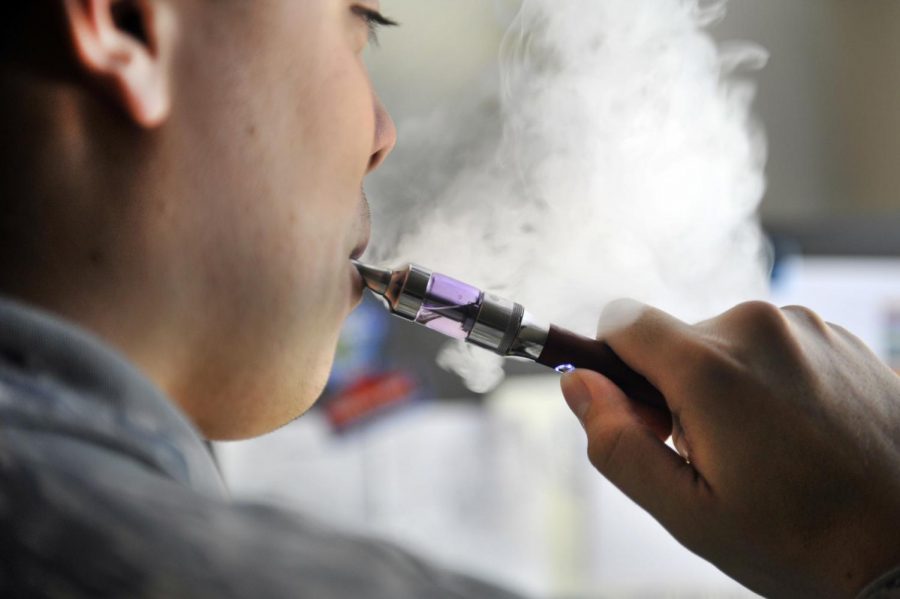Vaping: A Harmful Trend
October 7, 2019
In recent years the habit of vaping has been taken up by teens, the amount of kids participating in this practice only seems to increase. The introduction of E-cigarettes to Americans dates back to 2007, but it’s sales began steadily increasing after 2011.
The creation of E-cigarettes is relatively recent compared to cigarettes, therefore the amount of study and research surrounding the possible long term effects of using them is not in abundance. Their usage is often seen as a harmless alternative to cigarettes, but can the smoking replacement have harmful effects that make it just as bad as smoking?
Vaping is done via E-cigarettes, also known as vape pens. Instead of relying on the burning of a cigarette to intake nicotine, e-cigarettes create vapor. Within it, nicotine liquid is heated, allowing it to convert into vapor, the user then inhales the vapor—which then travels to the lungs. The vapor is seen as a healthier alternative to smoking, whose dangers and effects are well known. The usage of nicotine liquid has been popularized because of the various flavors they are sold in—another appealing aspect of the vape pen. Flavors include mint, chocolate, apple, menthol, cotton candy, etc.
The various flavors of the vape pen and their seemingly harmless nature—compared to cigarettes—all add to their appeal to teenagers.
Hence why studies have shown that the vape pen has been the most prominent tobacco product utilized among middle schoolers and High Schoolers since 2014; despite the requirement for legally purchasing one being eighteen. In 2011 statistics show that in the U.S., among middle school and high school students, only 1% of girls and 2% of boys regularly were in use, now the number has been raised to 19% and 23% respectively.
I asked a student, who wished to remain anonymous, about why they think vaping holds such great popularity among teens.
“It’s popular because teens see it as better than smoking. They misguidedly think that it doesn’t harm you the way regular cigarettes, plus there are all sorts of flavors to try.”
Since e-cigarettes are relatively new compared to cigarettes, studies that indicate the long term effects of usage, to them specifically, aren’t available. Some effects linked to nicotine usage, which can be done via vaping, include the increased possibility for addiction, stumped brain development, and damage to the respiratory system.
The aerosol, released from e-cigarettes, does not only release the harmful substance nicotine but also ultra fine particles, volatile organic compounds, and heavy metal particles. These substances can lead to the development of lung diseases. Researchers and experts haven’t had enough time or resources to fully understand what people are inhaling while using them. People don’t know whether or not they’re in taking harmful chemicals into their bodies. One study conducted by the FDA in 2009 indicated, after analyzation, that nicotine cartridges contained different nicotine amounts than the amount given by the label. They also found nicotine in the vaping liquid that was sold as “nicotine-free”. Further analysis found that the deposits carried harmful toxins that have been connected to causing cancer.
Since the brain is still in its development process during adolescence, teens are more at risk to suffer from long term effects from nicotine; including addiction, mood disorders, and a decrease in impulse control.
The usage of nicotine also makes people more susceptible to addiction, which can lead to the development of an addiction to harder drugs. Vaping is also seen as a gateway to the usage of other tobacco products; those who vape are more likely to end up smoking. Not only does partaking in vaping increase the possibility of developing these detriments, but also inhaling the secondhand vapor can also have an effect on health—vaping not only harms an individual user but also on those who are exposed to it in any way.
The rising trend of vaping among teens has become a concern. Especially since not much is fully known about the chemicals used and the long term effects that they may entail. Students aren’t even legally supposed to have access to e-cigarettes.
Because of these concerns, many anti-tobacco groups have made campaigns and ads warning against vaping. Students should consider the consequences before partaking in an activity in which the full extent of the, possibly harmful, effects are unknown. For more information about vaping and its effects you can click here (https://e-cigarettes.surgeongeneral.gov/getthefacts.html).
